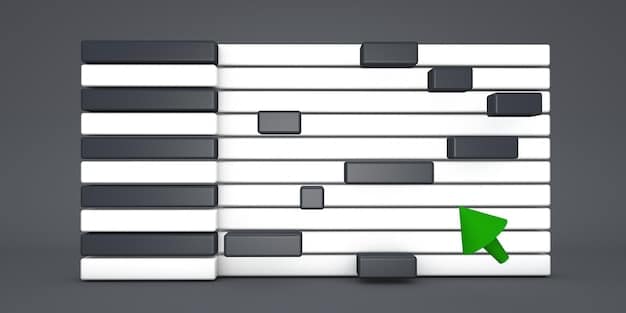Drum Programming Masterclass: Craft Punchy and Groovy Beats

This Drum Programming Masterclass reveals essential techniques for crafting punchy and groovy beats, covering everything from selecting the right samples and understanding rhythm to mastering advanced sequencing and mixing for professional-sounding drum tracks.
Ready to elevate your music production game? This Drum Programming Masterclass: Craft Punchy and Groovy Beats provides you with actionable tips and techniques to create compelling rhythms that will set your tracks apart. Let’s dive in and unlock the secrets to crafting professional-quality beats.
Understanding the Fundamentals of Drum Programming
Before you can start crafting those killer beats, it’s crucial to understand the basic elements that make up effective drum programming. This includes understanding different drum sounds and their roles, rhythm and timing, and the importance of groove.
The Essential Drum Sounds
Every drum kit, whether virtual or acoustic, consists of a few key elements. Understanding their individual properties will significantly impact how you use them when creating beats.
- Kick Drum: The foundation of your rhythm, providing the low-end punch. Experiment with different kick samples to find one that suits your track’s style.
- Snare Drum: Adds character and often defines the backbeat. Consider the snare’s tuning, reverb, and overall tone to create unique textures.
- Hi-Hats: These provide rhythmic drive. Vary the patterns between closed, open, and pedal hi-hats for added complexity.
- Cymbals: Crashes, rides, and other cymbals add accents and embellishments, making the beat feel more natural.
Choosing the right drum sounds is the first step in creating powerful drum tracks, so try different sounds and identify what makes your favorite tracks sound great.
Rhythm and Timing
Rhythm and timing are the backbone of any groove. Understanding concepts like beat divisions, swing, and syncopation can add nuance.
- Beat Divisions: Break down the beat into smaller segments (e.g., eighth notes, sixteenth notes) to introduce intricate patterns and fills.
- Swing/Shuffle: Adjust the timing to create a looser, more human feel. Apply swing subtly to add a unique groove.
- Syncopation: Placing notes off the main beats can create interesting rhythmic tensions. Experiment with off-beat hi-hats or snare hits.
Solid rhythm and timing foundations significantly affect the overall feel of your beats. Try playing around with different rhythmic and timing techniques to improve the feel of your beats, whether you want a driving track, or something more laid back.
Understanding the foundations of drum sounds, timing, and rhythm allows you to craft beats that are more thoughtful and sound better. Experiment with different sounds and beats to find your own personal style.
Selecting the Right Drum Samples
The quality and character of your drum samples can make or break your beat. Choosing the right samples involves considering factors like genre, style, and overall sonic aesthetic. High-quality, well-processed samples can save time and enhance the overall sound.

Curating Your Sample Library
Building a versatile sample library is essential for every producer. Here are some tips to help you curate your collection.
- Diverse Sources: Gather samples from various sources, including commercial packs, free downloads, and even recording your own sounds.
- Organized Folders: Categorize samples by type (kick, snare, etc.) and style (acoustic, electronic, etc.) for easy access.
- Quality Control: Weed out low-quality or redundant samples to keep your library lean and efficient.
Having a well-organized and high-quality library will not only improve the sound of your beats, but it’ll speed up the production process, too.
Layering Samples for Unique Sounds
Layering involves combining multiple samples to create richer, more complex sounds. This technique can be used to create unique and signature drum tones.
Experiment with using different drum sounds as different layers to find out the effect that it has to the finished drum beat. Using reverb, EQ, or compression will also enable to fine tune the drum beat and glue each sound together.
Selecting and curating the right sample library, and using techniques like layering enable a huge amount of control over the sound. It can take some time to find your own groove with your sound, but the journey is well worth it.
Mastering Basic Drum Patterns
Basic drum patterns are the building blocks of most genres. Mastering these can provide a solid foundation for creating more complex and innovative rhythms. Let’s explore some essential patterns.
The Four-on-the-Floor Beat
The four-on-the-floor pattern, common in house and techno music, involves a kick drum on every beat and a snare on beats two and four. Hi-hats typically play eighth notes providing a driving rhythm.
With its steady kick drum rhythm, the four on the floor pattern ensures a high degree of energy and groove. Despite its seeming simplicity, with some small enhancements, it can be a solid base for dance music.
The Hip-Hop Beat
Hip-hop beats often feature a syncopated kick and snare pattern, with hi-hats adding texture and rhythmic variation. Experiment with different snare sounds and ghost notes for added complexity.
- Kick Placement: Use the kick to emphasize particular rhythmic accents, often dodging the typical four-on-the-floor pattern.
- Snare Variations: Try rimshots or claps in addition to the usual snare placement on beats two and four.
- Hi-Hat Rhythms: Experiment with different hi-hat patterns, including triplets or syncopated rhythms, to keep the groove fresh.
As hip-hop is based on the kick and snare, altering the pattern slightly has a huge impact on the end results. Consider also the tempo, and amount of reverb, to keep the track sounding fresh.
The Reggae Beat
The reggae beat is characterized by a strong emphasis on the off-beat, with the kick and snare often playing on the third beat of each measure. Hi-hats and other percussion elements add to the laid-back feel.
Reggae drum patterns focus on rhythm and groove to provide a specific laid back but catchy groove. Consider the amount of reverb, and the feel you’re after, to get great results.
Mastering basic drum patterns like four-on-the-floor, hip-hop, and reggae gives you a strong footing from which to build more complex drum rhythms. Try them out, alter and try new sounds to produce unique sounding tracks.
Advanced Sequencing Techniques
Once you’re comfortable with basic patterns, it’s time to explore advanced sequencing techniques. These methods add depth, variation, and human feel to your drum programming.
Velocity and Dynamics
Varying the velocity (loudness) of each drum hit can make a beat sound more natural and expressive. Subtle changes in velocity add depth, while more drastic changes create dynamic shifts.

- Ghost Notes: Reduce the velocity of snare hits to create subtle ghost notes that add rhythmic interest.
- Dynamic Buildups: Gradually increase the velocity of certain elements (e.g., hi-hats) to create tension and energy.
- Pattern Accents: Emphasize certain beats or bars by slightly increasing the velocity of the kick or snare.
Velocity and dynamics are often overlooked, but they’re an easy way to introduce subtle changes that hugely impact the overall feel of the music. Make sure you use this to improve your beats.
Fills and Variations
Drum fills are short, improvisational passages that break up repetitive patterns and signal transitions. Use fills to transition between sections or add excitement to the music.
Drum fills can range from simple variations to complex patterns. Try patterns that incorporate extra tom rolls or cymbal crashes. Use automation on effects like reverb or delay to create unique textures during fills.
Using velocity and dynamics, and variations in the music adds depth, complexity, and feel to your music. With simple techniques, it’s easy to add a huge amount of feel to the beat. These techniques make your drum beats sound more human, and in turn translate well to the dancefloor.
Mixing Your Drums for Impact
A well-mixed drum track can make or break a production. Mixing involves using EQ, compression, reverb, and other effects to shape the sound and make your drums impactful. Getting the mix right is key to crafting professional, punchy beats.
EQing Your Drums
EQ (equalization) is used to adjust the frequency content of your drum sounds. Use EQ to remove unwanted frequencies, enhance desirable ones, and carve out space for each element in the mix.
- Kick Drum: Boost the low-end frequencies (40-60 Hz) for added punch, and cut muddiness around 200-300 Hz.
- Snare Drum: Enhance the snare’s body around 200-300 Hz, and add brightness by boosting high frequencies (5-8 kHz).
- Hi-Hats: Use a high-pass filter to remove low-end rumble, and gently boost high frequencies for added clarity.
EQ is important for getting a clear and balanced mix. It allows each sound within a track to have its own space, meaning it doesn’t get muddy, and translates well across different speaker systems.
Compression Techniques
Compression reduces the dynamic range of a sound, making it louder and more consistent. Use compression to add punch, glue, and control the dynamics of your drums.
Compression is important as it glues all your sounds together. Experiment with different compressor settings (attack, release, threshold, ratio) to achieve different effects.
From balancing each element, to gluing them together with compression, mixing is an enormously important part of any drum beat. Without mixing, the individual parts lack cohesion, potentially resulting in a muddy mix.
Adding Groove and Feel
Groove and feel are intangible qualities that make a beat compelling and danceable. Adding groove involves using techniques like swing, humanization, and subtle timing variations to create a beat that feels alive.
Swing and Shuffle
Swing and shuffle add a looser, more human feel to your beats. Adjust the timing of certain notes to create a subtle rhythmic push and pull.
Experiment with different swing percentages to find the perfect balance between tight and loose. A small swing can dramatically alter the perceived feel of the music without making it overly messy. Often the biggest determining factor is personal taste and artistic focus.
Humanization and Randomization
Humanization involves adding subtle variations to timing, velocity, and other parameters to mimic the imperfections of a human drummer. Randomization can introduce these variations automatically.
Subtle changes in timing and velocity can make a beat sound much more realistic and engaging. These subtle elements can make the drum beats sound like they’re naturally sequenced, rather than rigid and robotic.
By use of swing, shuffle, humanization and randomization, you can make seemingly robotic drums sound like they’re being played by a real person. Try these different techniques and adjust to find a groove that you like.
| Key Point | Brief Description |
|---|---|
| 🥁 Drum Sound Selection | Choosing the right drum sounds (kick, snare, hi-hats) is crucial for the overall feel. |
| ⏱️ Rhythm and Timing | Understanding beat divisions, swing, and syncopation adds nuance to beats. |
| 🎚 Mixing Techniques | EQ and compression are essential for shaping the drum sounds and creating impact. |
| ✨ Groove and Feel | Swing, humanization, and randomization add a natural, danceable quality to the beat. |
FAQ
▼
The main elements include selecting the right drum samples, understanding rhythm and timing, and using techniques like velocity and swing to add groove and human feel to your beats. These should all be considered when drum programming.
▼
To improve the quality of drum samples, curate a diverse library from reliable sources, organize them effectively, and don’t be afraid to replace your least favorite samples with new ones.
▼
You can add groove with swing, humanization, and subtle timing variations which emulate real drummers and get your track sounding more organic. Experiment with varying dynamics and patterns too.
▼
Mixing is super important in drum programming because it shapes the sonic picture of your drums, ensuring each sound has its space and volume, resulting in a professional, balanced result.
▼
Using professional-quality samples, advanced sequencing techniques, and fine-tuning your mix, it’s easy to get good results. Practice often to develop your skills so your ear becomes more in tune.
Conclusion
In conclusion, mastering drum programming involves understanding the fundamentals, selecting the right samples, mastering basic patterns, and using advanced sequencing and mixing techniques. By incorporating these strategies, you can craft punchy and groovy beats that elevate your music productions to the next level.





